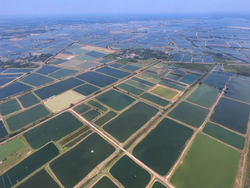
Why freshwater aquaculture is key to global seafood security?
Editor:Mohamed Shihab
Freshwater aquaculture, not mariculture, is the key to improving global food security, according to a new paper by some of the world’s preeminent aquaculture academics.https://thefishsite.com/articles/why-freshwater-aquaculture-is-key-to-global-seafood-security.
Freshwater aquaculture dominates global aquaculture production, but its importance is often overlooked in the global food-policy agenda and research. In a new study published in Nature, academics – including Wenbo Zhang, Ben Belton, Dave Little and Max Troell – argue that recent research underestimates the production potential for freshwater aquaculture and inflates the importance of mariculture, or saltwater aquaculture.
Since the 1980s marine and inland fishing has grown very little, while all sectors of aquaculture are increasing production and market share. However, not all aquaculture is equal. While mariculture has attracted the lion’s share of research funding and policy attention, freshwater aquaculture is the heavy lifter when it comes to producing fish that are available and affordable to low- and middle-income consumers globally.
Finfish mariculture is focused on farming expensive carnivorous species of fish for high end markets, but per capita aquatic food consumption in high-income countries has plateaued since 2000. The authors expect that future increases in demand for aquatic foods will mainly come from the Global South, which is why developing low-cost freshwater aquaculture systems is more important for meeting future global demand.
“We think freshwater aquaculture producers and consumers are underrepresented in the global aquatic food policy agenda, but in fact they are the ‘silent majority’,” said co-author Ben Belton, in a press release from Michigan State University.
This study, called Aquaculture will continue to depend more on land than sea, responds to a paper published in the Nature in 2020 by Costello et al., which argues that mariculture has greater potential to expand than freshwater aquaculture, in line with the abundant number of policy-related publications on mariculture compared to freshwater aquaculture.
Zhang et al., in contrast, highlight that freshwater aquaculture accounts for the majority (77 percent) of edible aquaculture production, and argue that Costello et al. inflate mariculture production potential in several ways.
The authors of the new study note that Costello et al. “exclude crustacean production from their models, define brackish water agriculture as mariculture, conflate freshwater capture fisheries and freshwater aquaculture, and are overly optimistic about potential of future mariculture technologies”.
Of all farmed finfish, about 80 percent are produced in freshwater, dominated by herbivorous and omnivorous freshwater species. Meanwhile most mariculture finfish species are carnivorous and require more expensive feed resources. Zhang et al. therefore argue that mariculture is receiving excessive attention in scientific literature, which can result in flawed policies and misguided investments.
The new paper goes on to refute the common misconception that the development of freshwater aquaculture is limited by availability of freshwater and arable land, while the space for mariculture to expand at sea is almost unlimited. Life cycle assessment studies show that for fed fish species, both freshwater aquaculture and mariculture, require freshwater and arable land for the provision of feed on aquaculture farms. Furthermore, mariculture´s need for infrastructure is large for both open sea cages and tank-systems on land. Freshwater aquaculture is not more constrained by available space than mariculture, while large potential exists for further intensification and expansion of freshwater aquaculture production.
“Balanced approaches to science, policy and investment that prioritize freshwater aquaculture development in addition to mariculture can contribute more to global food security than those favouring mariculture alone,” said Max Troell, another of the paper’s authors.
The new paper argues that freshwater aquaculture produces more food, with less expense than mariculture, and has potential to continue expanding through both small-scale and large-scale inland pond production. Farmed freshwater fish are often lower on the food chain than marine finfish, so their food inputs are less expensive than those needed by species farmed in mariculture. Despite these benefits and possibilities for expansion, most research has been focused on mariculture. The authors of this paper suggest that greater investment in freshwater aquaculture research is key to creating global food security.


ساحة النقاش